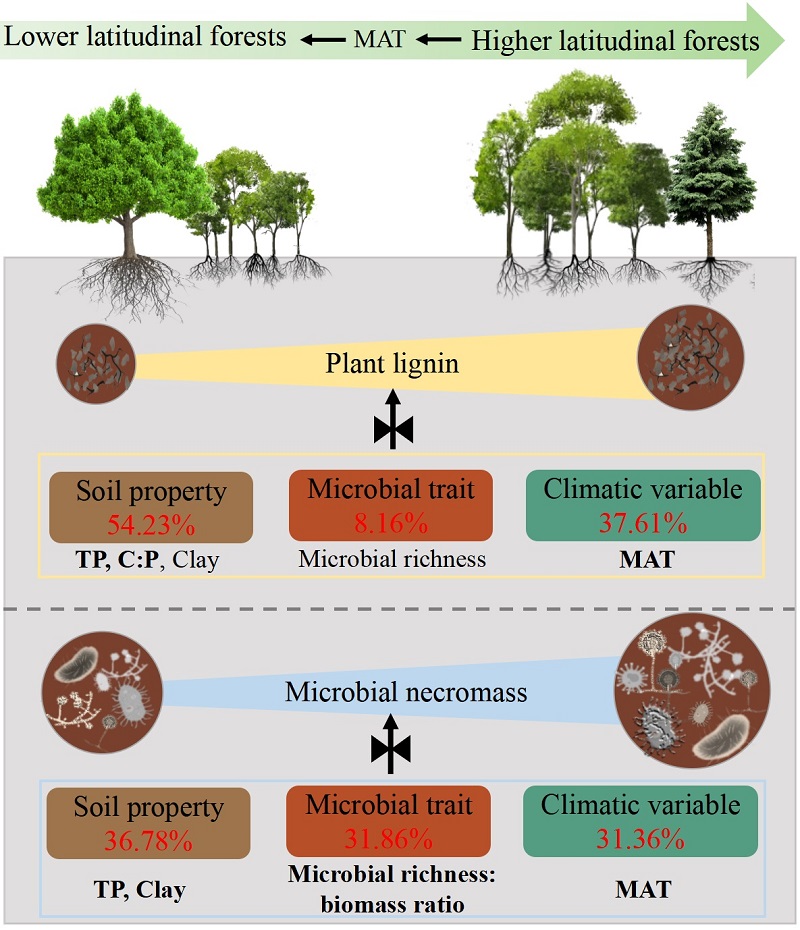The latitudinal patterns and driving factors of plant lignin and microbial necromass accumulation in eastern forests of China
Plant- and microbial-derived compounds are the two primary sources of soil organic carbon. However, how biotic and abiotic factors regulate the contributions of plant and microbial residue carbon to soil organic carbon at a regional scale remains unclear.
This study focuses on five latitudinal forests in eastern China, using lignin phenols and amino sugars as biomarkers, along with climate, soil properties, and microbial community characteristics to investigate the patterns and drivers of plant and microbial residue contents and their contributions to soil organic carbon. The study found that the contents of lignin phenols and amino sugars in soil gradually increases with latitude, whereas their contributions to SOC represented contrasting patterns along the latitudinal gradients. Correlation analysis indicates that the contribution of microbial necromass carbon to soil organic carbon increases with increasing soil organic carbon content, while the contribution of plant lignin to soil organic carbon shows no significant relationship with soil organic carbon. Multiple regression models reveal that the contents of plant lignin and microbial necromass carbon and their contributions to soil organic carbon are mainly influenced by the joint effects of climatic variables, microbial traits, and soil properties. Specifically, mean annual temperature and soil phosphorus content are the main controlling factors for plant lignin accumulation, whereas mean annual temperature and the microbial richness: biomass ratio are central to microbial necromass carbon accumulation.
The results suggest that the disproportionate impacts of microbial traits (especially microbial richness: biomass ratios) on the accumulation of plant lignin and microbial necromass in forest soils of eastern China. These findings have important implications for understanding the contributions of plant lignin and microbial necromass to soil organic carbon and their accumulation mechanisms in forest soils in eastern China, thus facilitating the prediction of carbon sink potential in forest ecosystems under future global climate changes.
The research has been published in the journal of Soil Biology and Biochemistry titled "Latitudinal patterns and drivers of plant lignin and microbial necromass accumulation in forest soils: Disentangling microbial and abiotic controls.". Dr. Jinhong He, a postdoctor from the Heshan Station of the South China Botanical Garden, Chinese Academy of Sciences (now affiliated with the Guangzhou Institute of Forestry and Landscape Architecture), and Associate professor Yanxia Nie are co-first authors, with Associate professor Xiangping Tan as the corresponding author. This research was supported by the Guangdong Basic and Applied Basic Research Foundation, the National Natural Science Foundation of China, and the National Key R&D Program of China. Article link: https://doi.org/10.1016/j.soilbio.2024.109438
Yanxia Nie: Associate professor, Research Center for Ecology and Environmental Sciences, South China Botanical Garden, Chinese Academy of Science, Research field: Microbial community structure and N cycle, E-mail: nieyanx@scbg.ac.cn. Tel:15919318156

File Download: